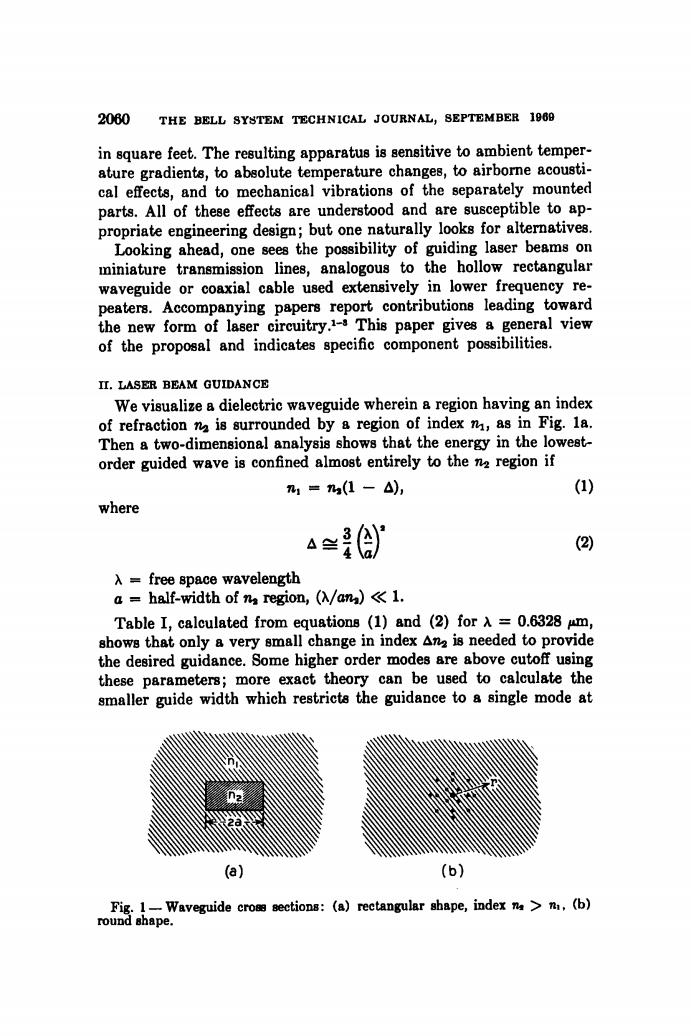正在加载图片...

2080 THE BELL SYSTEM TECHNICAL JOURNAL,SEPTEMBER 1969 in square feet.The resulting apparatus is sensitive to ambient temper- ature gradients,to absolute temperature changes,to airborne acousti- cal effects,and to mechanical vibrations of the separately mounted parts.All of these effects are understood and are susceptible to ap- propriate engineering design;but one naturally looks for alternatives. Looking ahead,one sees the possibility of guiding laser beams on miniature transmission lines,analogous to the hollow rectangular waveguide or coaxial cable used extensively in lower frequency re- peaters.Accompanying papers report contributions leading toward the new form of laser circuitry.1-s This paper gives a general view of the proposal and indicates specific component possibilities. II.LASER BEAM GUIDANCE We visualize a dielectric waveguide wherein a region having an index of refraction na is surrounded by a region of index n,as in Fig.1a. Then a two-dimensional analysis shows that the energy in the lowest- order guided wave is confined almost entirely to the n2 region if 1=n(1-△), (1) where (2) A=free space wavelength a half-width of na region,(A/ana)<1. Table I,calculated from equations (1)and (2)for A 0.6328 um, shows that only a very small change in index Ana is needed to provide the desired guidance.Some higher order modes are above cutoff using these parameters;more exact theory can be used to calculate the smaller guide width which restricts the guidance to a single mode at (a) (b) Fig.1-Waveguide cross sections:(a)rectangular shape,index na n,(b) round shape.2060 THE BELL SYSTEM TECHNICAL JOURNAL, SEPTEMBER Ιθβθ (2) λ = free space wavelength a = half-width of n , region, (λ/αη^) « 1. Table I, calculated from equations (1) and (2) for λ = 0.6328 μχα, shows tha t only a very small change in index Δη^ is needed to provide the desired guidance. Some higher order modes are above cutoff using these parameters; more exact theory can be used to calculate the smaller guide width which restricts the guidance to a single mode a t Fig. 1 —Waveguid e cross sections: (a) rectangular shape, index m > ni , (b) round shape . in square feet. The resulting apparatus is sensitive to ambient temperature gradients, to absolute temperature changes, to airborne acoustical effects, and to mechanical vibrations of the separately mounted parts. All of these effects are understood and are susceptible to appropriate engineering design; but one naturally looks for alternatives. Looking ahead, one sees the possibility of guiding laser beams on miniature transmission lines, analogous to the hollow rectangular waveguide or coaxial cable used extensively in lower frequency repeaters. Accompanying papers report contributions leading toward the new form of laser circuitryThi s paper gives a general view of the proposal and indicates specific component possibilities. Π. LASER BEAM GUIDANCE We visualize a dielectric waveguide wherein a region having an index of refraction is surrounded by a region of index τ^, as in Fig. la . Then a two-dimensional analysis shows tha t the energy in the lowestorder guided wave is confined almost entirely to the region if n, = n,(l - Δ), (1) where